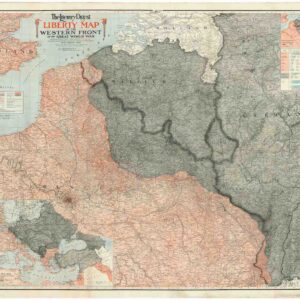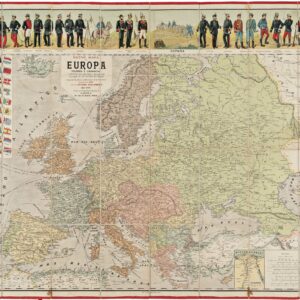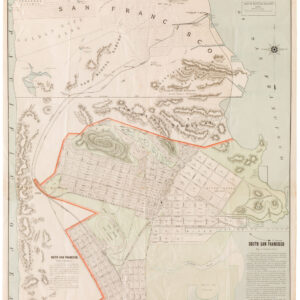World War I propaganda map of German submarine attacks.
[Persuasive Cartography] Ubootswirkung im Mittelmeer.
$1,900
In stock
Description
This evocative propaganda poster map was produced by the German Admiralty, or Admiralstab, as the end of World War I was slowly coming into sight. The map is designed with a simple yet effective impact on its viewer. The subject matter is the Mediterranean Sea, which is in a uniform blue, while the surrounding landmasses are kept in a mustard yellow. All the massaging on the poster is done in bold and bloody red.
Despite Germany’s inevitable defeat just nine months after this propaganda map was published, the imagery defiantly boasts about the number of ships that the German Imperial Navy’s U-boats have sunk over the last 12 months. Each of the confrontations ending in such sinking is depicted as a small sinking-ship pictogram placed near the location of their demise. Even though the Mediterranean is in focus, many ships are also shown as having been sunk in the Bay of Biscay.
On the landmasses, texts in bold red stress that none of the depicted vessels were sunk before February 1st of 1917, and none were dropped by mines. At the bottom of the map a quote from the New York Times (4th November 1917) reads in German: “Die wichtigste unmittelbare militärisceh Ursache der italienischen Niederlage wird unwidersprochen in dem Mangel an Munition und schweren Kanonen erblickt: denn die Unterseeboote haben die Erz- und Kohlenzufuhr unterbunden” (The most important immediate military cause of the Italian defeat is undisputedly seen in the lack of ammunition and heavy cannons: the submarines have cut off the supply of ore and coal).
This poster map doesn’t just speak to collectors of World War I memorabilia but is part of a broader trend in which pictorial cartography was used for political or military propaganda.
Census
The Admiralstab der Kaiserliche Marine produced the map in March of 1918. Two editions were made, with an earlier edition noting only the results from 11 months of U-boat warfare rather than the 12 months included here. This reflects how quickly the war was progressing at this stage.
This poster is scarce in institutional collections. The OCLC lists five institutional holdings in Germany (Staatsbibliothek zu Berlin, Universität Leipzig, Universitäts- und Landesbibliothek Darmstadt, Bayerische Staatsbibliothek, and the Deutsche Nationalbibliothek Leipzig) and one copy at the Dutch University of Utrecht. We have also found examples in the Imperial War Museum in London (IWM PST 7633) and the Hoover Institution at Stanford (Poster GE 298; Record no. XX343.6846).
Examples of the earlier “11-month” state can be found in the Landesarchiv Baden-Württemberg in Stuttgart (ID no. J 151 Nr 2260) and a rare uncolored version in the Imperial War Museum (IWM PST 7645).
Cartographer(s):
The origins of the Admiralstab der Kaiserliche Marine trace back to the Allerhöchste Kabinettsordre of December 14, 1875, which called for establishing an Admiralty as an operational leadership organ of the Naval High Command. Despite initial directives, when Kaiser Wilhelm II assumed direct command over the navy in 1899 and dissolved the Naval High Command, only the Admiralstab department remained. It was then reorganized and placed directly under the authority of Wilhelm II. The Admiralstab‘s tasks included continuing previous duties and the military-political oversight of ships stationed abroad. However, Admiral Alfred von Tirpitz intentionally kept its significance minimal, aimed to avoid competition with the Reichsmarineamt, ensuring that the Admiralstab remained primarily a “war study authority” rather than a rival to the army’s Generalstab.
During World War I, the Admiralstab served as one of the four top command authorities of the German Imperial Navy, playing a crucial role in the naval operations. The fragmented naval leadership soon proved detrimental to the war effort. It was not until the Seekriegsleitung was established in August 1918 that unified leadership was achieved, albeit far too late, to impact the course of the war. After the war, the Admiralstab was placed under the Reichsmarineamt‘s authority and ultimately dissolved by presidential decree on September 15, 1919.
Condition Description
Tape restorations visible on the verso and various blemishes and chips visible on recto. Image intact and nice.
References


![Delimitation de la Zone Occupee [German Occupation of France]](https://neatlinemaps.com/wp-content/uploads/2019/12/NL-00782-scaled-300x300.jpg)
